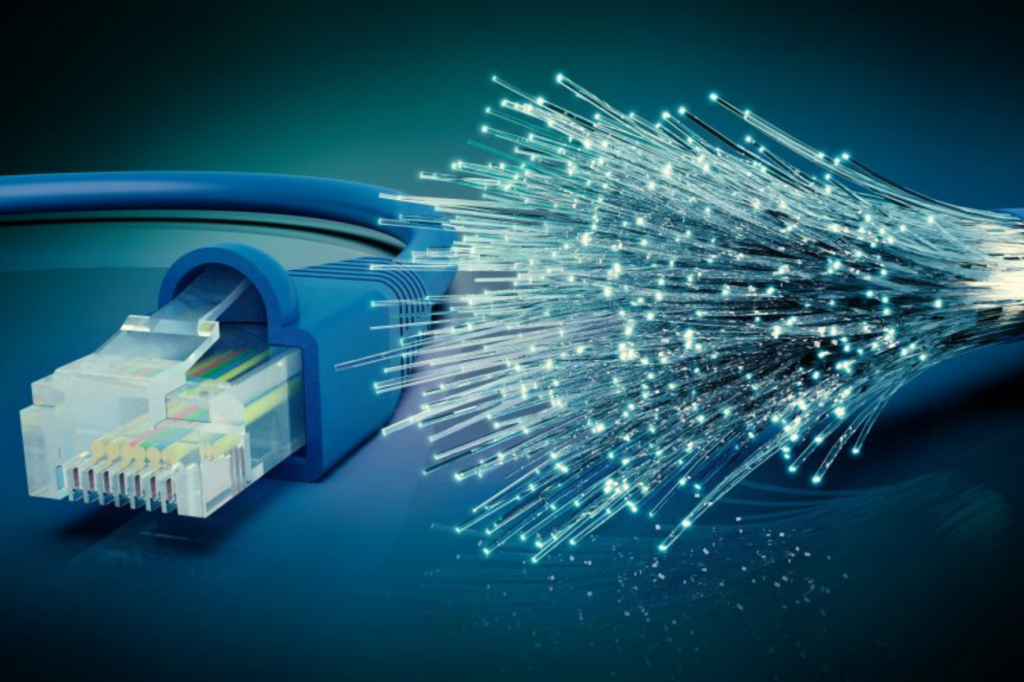Contents
What is Aerial fiber optic cable
Aerial fiber optic cable is a type of outdoor cable designed to be installed above ground, typically suspended between utility poles or towers. It consists of optical fibers enclosed in a protective outer sheath, allowing for reliable data transmission over long distances while enduring exposure to outdoor elements such as UV radiation and temperature fluctuations. These cables are commonly used in telecommunications networks to provide high-speed internet and communication services to communities.

Types of Aerial Fiber Optic Cable
Aerial fiber optic cables are designed to be installed above ground, typically suspended between utility poles, towers, or other elevated structures. These cables come in various types, each tailored to meet specific installation requirements and environmental conditions. Here are some common types of aerial fiber optic cables:
All-Dielectric Self-Supporting (ADSS) Cable: ADSS cables are designed for aerial installations without the need for additional support structures like messenger wires or cables. They feature a unique construction with a central strength member surrounded by optical fibers and a weather-resistant outer sheath. ADSS cables are commonly used in long-span applications where traditional aerial installations may be challenging or impractical.

Optical Ground Wire (OPGW) Cable: OPGW cables serve a dual purpose by combining optical fibers for data transmission with a grounding wire for electrical protection. They are commonly used in overhead power transmission lines, providing both communication and lightning protection capabilities. OPGW cables are designed to withstand high voltage and environmental stresses while maintaining reliable communication links.
Aerial Fiber Optic Cable Installation
The installation of aerial fiber optic cables involves several key steps to ensure proper deployment and reliable performance:
- Route Planning: Before installation, a thorough route planning process is essential to determine the optimal path for the aerial cable. Factors such as terrain, existing infrastructure, and regulatory requirements must be considered to minimize obstacles and ensure a smooth installation process.
- Pole Preparation: Utility poles or towers along the route must be inspected and prepared for cable installation. This may involve clearing obstructions, reinforcing or replacing damaged poles, and securing necessary permits from local authorities.

- Cable Installation: The aerial fiber optic cable is carefully installed along the predetermined route, using specialized equipment such as aerial bucket trucks or cable lashing machines. Proper tensioning and support are crucial to prevent sagging and ensure the cable remains securely in place.
- Hardware Installation: A variety of hardware components are used to support and secure the aerial cable to the support structures. These include suspension clamps, pole brackets, guy wires, and dead-end grips, which are installed at regular intervals to maintain tension and stability.
Aerial Fiber Optic Cable Hardware
Aerial fiber optic cable hardware plays a vital role in supporting and securing the cable along its route. Here are some common hardware components used in aerial installations:
- Suspension Clamps: Suspension clamps are used to attach the aerial cable to support wires or messenger strands strung between poles. They provide support and prevent the cable from sagging between spans.

- Pole Brackets: Pole brackets are used to secure the aerial cable directly to utility poles or towers. They are typically mounted at strategic locations along the route to provide additional support and stability.
- Guy Wires: Guy wires are tensioned cables attached to poles or towers to provide additional support and stability, especially in areas with high winds or other environmental factors.
- Dead-End Grips: Dead-end grips are used to terminate the aerial cable at the end of a span or at intermediate points along the route. They provide a secure anchor point and prevent the cable from slipping or loosening over time.
Aerial Fiber Optic Cable Installation Guide
Here’s a step-by-step guide for installing aerial fiber optic cables:
- Route Planning: Conduct a thorough survey of the installation route, considering terrain, obstacles, and regulatory requirements.
- Pole Preparation: Inspect and prepare utility poles or towers along the route, ensuring they are structurally sound and capable of supporting the aerial cable.
- Cable Installation: Use specialized equipment to install the aerial cable along the predetermined route, maintaining proper tension and support.

- Hardware Installation: Install suspension clamps, pole brackets, guy wires, and dead-end grips at regular intervals to support and secure the cable.
- Testing and Inspection: After installation, conduct testing to ensure the cable is functioning properly and inspect hardware for any signs of damage or wear.
- Documentation: Keep detailed records of the installation process, including route maps, permits, and equipment specifications, for future reference and maintenance.
Conclusion
In conclusion, aerial fiber optic cables are essential for establishing reliable communication networks over long distances, offering connectivity even in challenging outdoor environments. By understanding the installation process, hardware requirements, and following best practices, network installers can ensure successful deployment and optimal performance of aerial fiber optic cable installations.
FAQs
What is the lifespan of aerial fiber optic cables?
How do you protect aerial fiber optic cables from environmental damage?
What are the advantages of using aerial fiber optic cables?
What is the difference between aerial and underground fiber optic cables?


Pingback: Ultimate Guide to Choosing the Best Ethernet Cable for PS4
Pingback: Fiber Optic Cable color code| Fiber Color Code chart 1
Pingback: Cutting-Edge Connectivity: How Much Does Installing Fiber Optic Cable in Home Cost? 1